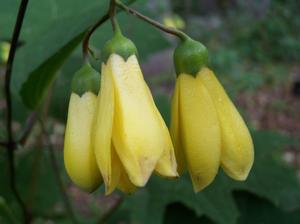
Showy late season flowers adorn the terminals of stems in a cyme arrangement
Kirengeshoma palmata - Yellow Waxy Bells
Yellow Waxy Bells, Kirengeshoma palmata (keer-eng-gih-SHO-muh pahl-MAY-tuh), is an unusual woodlander in a couple of ways. Deserving of wider audience this dramatic plant is related to the hydrangea clan. As with Deinanthe but unlike the shrubby hydrangeas that have probably come to your mind's eye Kirengeshoma is a herbaceous perennial, dying down to the crown when temperatures grow cold. Yellow Waxy Bells loves open deciduous shade, dappled sun is fine - this placing its culture solidly in the woodland category. One other feature distinguishes it from most woodland denizens; rather than beginning the growing season with flowers this beauty's climatic glory occurs in late summer and early autumn.
Kirengeshoma palmata is a well-behaved Japanese and Korean woodlander found naturally in mountainous areas. Growing four to five feet tall in an especially moist season it may stretch to six feet. An established clump after settling in happily relishing its woodsy digs will expand to four feet wide but over the course of years may achieve a breadth of six to six and one-half feet. This perennial displays attractive palmate leaves. The maple-like leaves in opposite pairs are set several inches away from the next pair up and down the stems. They are not densely placed. In that this imposing perennial's multiple stems hold their leaves in open spacing Kirengeshoma exudes a surprisingly soft affect. Stems are glaucous, sturdy and, therefore, staking is not necessary. Some forms offer the added interest of purple-black stems. With all the work required in the proper running of a nursery staking is a time consuming art this gardener has avoided mastering.
The flowers of Yellow Waxy Bells are very un-hydrangealike, however... the common name provides a clue! The buds appear as perfect balls on paired axillary stems, the sepals are a darker green, and the clasped ball of petals a luminous, greenish-white. Clustered buds set in a cyme formation. The cymes are well spaced contributing to the overall airiness of this tall perennial. These trend and increase towards the top of the plant. It may be many weeks before the flowers unfurl. Large pale yellow thick-textured bell-shaped flowers hang in open clusters, the weight of them sometimes just bending the tops of flowering stems adding to gentle, casual appeal. Each floret measures one to one and one-half inches long in that warm yellow hue that softly glows in the shady realm. They put on quite an endearing show. Every year they grace the late season garden and continue to mid-autumn depending, of course, on the cold. Ours have survived light frosts succumbing only when temperatures plummet enough to spark the thought of a wood fire in the woodstove.
Low maintenance is a plus as Yellow Waxy Bells is undemanding. As previously stated plant Kirengeshoma in light shade, dappled shade or with some early morning sun in a woodland setting. Site it in a rich, moisture retenting loam, a woodland soil to which organic matter is a component and you will be rewarded. If planted in an impoverished soil your plant will not respond well. Also, adequate moisture is fundamental. In a too-dry soil or a site that suffers in summer drought Kirengeshoma will languish and weep unhappily and will signal its malaise quickly. An organic mulch of small wood chips and / or leaves is beneficial. Yellow Waxy Bells is hardy in USDA zone 5 through 8. I would caution more cool shade in the southern end of its range with increased attention to the need for constantly moist soil. It will be crucial.
A closely related cousin is Kirengeshoma koreana. Also late blooming it less commonly found in the trade but having grown both K. palmata would be my personal choice if forced to choose between the two.
Flowering partners for this unusual hydrangea relative in your garden could be Sanguisorba canadensis, Sanguisorba officinalis 'Lemon Splash', green and purple-leaved Cimicifuga (now clustered with the Actaea), and all late-season Monkshood (Aconitum) as well as large ferns. Any among the middle-sized to mammoth hostas and Rodgersia would also be worthy and bold companions.
For gardeners wanting something different well-behaved Kirengeshoma palmata would be a smart choice. Flowering late it fills void in the shade garden near the end of the season. It's low maintenance, undemanding and handsome. It provides late season nectar for the bees who are, indeed, drawn to it. Hardy to zone 5, it can be grown virtually throughout the region. Put this uncommon perennial, a fantastic herbaceous hydrangea relative on your wish list. Or find an appropriate spot in your garden now. Dig in. Have fun. You won't be sorry.
penned by Wayne Paquette, March 2014